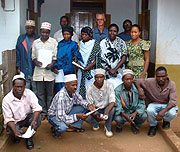 |








 |
 |

Collective Action and Governance
 |
|
 |
NEGOTIATION SUPPORT

Multi-stakeholder negotiations for improved management of a Mission boundary in Lushoto District, Tanzania. Participants negotiated replacement of Eucalypts with Markhamia obtusifolia, a tree exhibiting favorable characteristics according to each stakeholder.
 |
|
Given the tendency of think of watershed management as a technical or biophysical activity, AHI has given considerable attention to the role of collective action and governance in integrated natural resource management. This has included three primary areas of intervention: a) negotiation of natural resource management interventions that will harmonize the interactions among land users; b) participatory by-law reforms to minimize conflict or legalize resolutions reached through negotiations; and c) creation of social movements for better land stewardship.
Stakeholder negotiations have been discussed in some detail above. In brief, negotiations have been facilitated to enable a host of land management interventions: spring protection, niche compatibility in agroforestry, improved boundary management, regulations on livestock movement, soil and water conservation structures (location, spacing, connectivity) and common drainage from farmland, equitable distribution of new technologies, and nursery management. In the absence of stakeholder identification and negotiation, watershed management interventions are likely to be less successful due to insufficient buy-in of some local groups or highly inequitable in its benefits. Participatory by-law reforms were piloted first in Kabale district as a means to minimize conflict in natural resource management. This work linked participatory by-law reforms at the local level up through higher level law enforcement agencies to give backing to the voice of farmers. This work is being applied in other sites both as a stand-alone tool (to improve governance of watersheds) and as a mechanism to support multi-stakeholder negotiations (by giving informal resolutions the weight of law). Finally, through the African Grassroots Initiative for Livelihood and Environment (AGILE), AHI has conducted action research to understand how large-scale social movements for improved land stewardship might be mobilized. This work builds upon existing capacities and "nodes of innovation" through appreciative inquiry and direct support to "champions"—be they farmer groups, development agencies or government—in the form of enterprises, policy reforms and training.
 |
 |
|